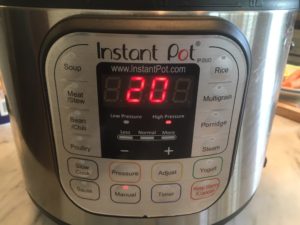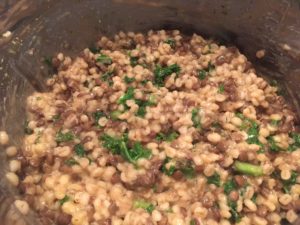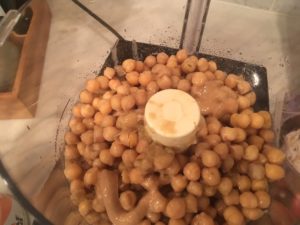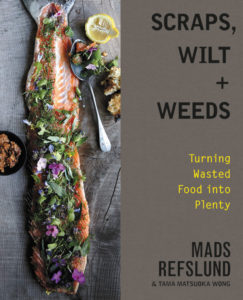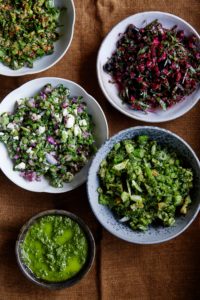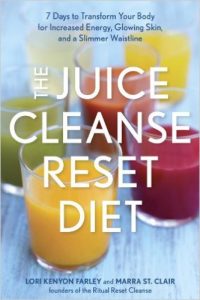Tag Archives: clean food
What We Eat
“Eat food, not too much, mostly plants.” –Michael Pollan
After over a decade on a whole-foods, plant-based diet – with long-term forays into oil-free as well – we started to take stock and make some changes. Neither of us had lost any weight, despite a reasonable exercise regime – and didn’t feel as energetic as we’d like. We were also concerned about brain health, sufficient quality Omega-3s, and took a lot of cues from the lifestyles of the “blue regions.”
To be clear, we don’t believe that there is any one diet that works for everyone. But there are some basic underlying givens – organic and non-GMO to start. The Environmental Working Group’s Dirty Dozen (or 18) and Clean 15 list (ewg.org) is the place we start to decide where to spend our organic food dollars. To augment what we get weekly from our CSA.
To change from such a long-time vegan lifestyle was not easy, but we both agreed it was time, We started by just adding a little fish to our diet to ensure quality omega-3s. But not just any fish or seafood – we made a list based on, again, the Environmental Working Group’s (ewg.org) high omega 3s and low mercury list combined with the Monterey Aquarium’s sustainability list. Those lists have since been combined so there is now just one easy source (ewg.org). With a couple minor exceptions, these are all wild-caught seafood from sustainable populations. We also have a secondary list that is not particularly beneficial, but not particularly harmful – either to us or to the environment. Clams, shrimp, even the occasional lobster lands on that treat list – but still, all wild caught. Nothing farmed, except for Rainbow Trout or from the evolving totally land-locked aquaculture community.
Our friends were delighted! Entertaining us was now so much easier. To accommodate our diet, they happily centered meals on wild-caught Alaskan salmon and everyone at the table was content.
After a year or so, we decided to look further. While we had lost weight on five-day all-organic juice and smoothie fasts, we inevitably gained it all back. We both wanted to lose about 15 pounds – permanently – to be healthier, look better, and regain large swaths of our closets. So we needed to find a diet that was satisfying for the long term and would also help us meet our weight goals.
We explored many options to find an approach that was grounded in evidence with a science that made sense. We decided to try Mark Hyman’s 21-day “Eat Fat, Get Thin” diet. It was pretty much life-changing for both of us. We found it very easy to follow, never felt deprived and started to lose weight – slowly and consistently. After our experiences on an oil-free plant-based diet, and having been steeped for decades in “low-fat” and “a calorie is a calorie” propaganda, it was really hard to add all those healthy fats. But we did, and, for us, it worked.
Hyman adopted the newly minted “PEGAN” to describe his maintenance plan – the best of paleo and vegan – and we have embraced a lot of it permanently. We still don’t eat meat or fowl. But we have dramatically limited our grains and beans, have added lots of healthy fats, continue to eat small portions of wild-caught fish and seafood, and are both at – or very near – our goal weights. Our plates are about 2/3-3/4 vegetables, 1/8-1/6 protein (fish, tofu, etc.), with nuts, seeds, organic extra-virgin olive oil, and three specific kinds of cheese as condiments. We cook only with avocado and organic coconut oils, (and very occasionally with ghee and organic sesame oil). The Organic EVOO is always added after cooking.
The grains: Quinoa (actually a seed), black rice, wild rice, organic brown rice (only occasionally and cooked in a big pot of water like pasta), Italian Arborio rice, amaranth, and millet. We experiment with a little bread – mostly organic mixed seeds and grains (Dave’s Killer) and whole-grain gluten-free (Udi’s). And we limit pasta to GF quinoa, red-lentil, and Miracle/Shirataki Noodles (made with Konjac). Plus we also spiralize a lot of veggies, which we actually find very satisfying.
Dairy: We continue to use only organic plant-based milk (almond and coconut plus canned full fat coconut milk) and, for the most part, plain organic coconut and almond yogurts. But we have also recently toyed with grass-fed organic full-fat cows milk Greek yogurt (Stonyfield’s Totally Grass-Fed Organic plain Greek yogurt) – to see how we feel. As for cheese – this is a very personal list: Only authentic Italian Parmigiano Reggiano, authentic Greek Sheep’s Milk Feta and French goat cheese (Chevre). That’s it. We trust these European sources far more than American ones and can find them easily even in the big box stores (they just cost a little more).
At the same time, we are giving up most vegan cheeses because they seem to be so full of undesirable ingredients. But we are withholding judgment because of the new wave of clean plant-based dairy from Miyoko, Kite Hill and other local sources. But as of now, they are very pricey. We have stopped eating most of the ersatz vegan substitutes like sour cream, some of the yogurts, and butter-substitutes because they have very long ingredient lists filled with things that we prefer not to consume. To date, we have not been successful in making our own plant-based yogurt. But we will continue to try.
Eggs? Yes! Pastured, organic, free-range. Three times as much as supermarket CAFO eggs, but there is a real difference that you can see and taste. And the consensus, at least this year, is that the right eggs are healthful. So an over-easy egg on a mess of steamed power greens (baby chard, spinach & kale with a pinch of turmeric) drizzled with EVOO is the standard breakfast these days.
Sweeteners are confined to organic stevia, organic maple syrup, organic dates and organic strawberry jam – and an occasional drizzle of hyper-local honey from our neighbors’ hives. We also stock organic peanut butter, sun butter, and almond butter, along with an array of olives, capers, pickles, artichoke hearts and lots of other unctuously lovely foods. Umami comes from an assortment of mustards and five kinds of miso. We’ll leave a full panty list for another post, but suffice it to say there is very little processed food of any kind.
Beverages are mostly organic green tea, lemon filtered water, iced tea, an occasional glass of wine (and for my husband coffee and beer).
Bottom line, we rarely, if ever, feel deprived, and find it remarkably easy to dine out or be a dinner guest (we just get a little flexible and stay on course at home). We think that choosing what and how one eats should be a continually evolving process – informed by reliable, reproducible, evidence-based studies. That it is important to not get stuck with titles, or too invested in one’s food choices as a large a part of one’s identity – because then you feel less free to change. Try something that resonates and if it works, great. If it doesn’t, step back and try something else. (Oh, and BTW, my IBS which has informed my life for at least seven years has mostly disappeared……).
Vegan Pressure Cooking – New and Expanded
By JL Fields
Fair Winds Press 2018 $22.99
With all the discussions about the benefits of pressure cookers for preparing beans and grains, I was excited to read and cook from Vegan Pressure Cooking – especially since the revised, expanded edition includes special instructions for Instant Pots!
There are some helpful, basic tips on pressure cooking in general, adjustments for various types, and plethora of full-page, color photos of the finished dishes – for roughly half of all recipes. There’s a serious emphasis on beans and grains – which is where pressure cookers really shine. Sometimes, for green and other non-starchy vegetables, the set-up, pressure-raising and releasing takes longer than simply plopping a pot on the stove (or using the microwave).
I am an Instant Pot fan, but its size encourages tucking it away in the pantry. Out of sight; out of mind. I was counting on this book re-energizing that appliance. And it certainly did. As a result, the IP is still on the counter after a positive week of trying some of JL Fields’ recipes. I skipped the green beans as not logical for an IP and headed toward the beans and grains.
The first recipe was “Lentil, Kale and Barley Risotto.” Two cups of cooked lentils were defrosting in the fridge and kale and jalapenos were in the hydrator – so it was a perfect choice. The recipe worked exactly as described and was delicious – but three of us ate most of it (and the servings listed are 6-8). Next time, I would be less judicious with the jalapeno (the heat was barely detectable) and add the baked tofu as the author suggested (or perhaps a sliced vegan sausage or two) which might stretch it to the suggested servings. The photo was a very tight close-up so it was hard to tell if my effort looked like the author’s.
“Chickpea Hummus” was next. Homemade hummus is a staple in our house – but more often than not from cans. A quick, delicious version from dried beans would be welcome. The chickpeas were soaked for 24 hours and then sat, drained, in the fridge for a day. I subbed the white part of leeks for the onion (that’s what I had) and reduced the garlic by half (since aggressive garlic is not loved by all in this house). There were two problems – the 15 minutes under high pressure with natural release was not nearly long enough in an IP (I let it gurgle on saute for another 20 minutes). And the flavor was bland – particularly surprising because onion is not traditional. Perhaps adding cumin, or maybe more lemon. Next time, I will try high pressure for 20-25 minutes (after all, preserving the shape of the chickpea is not relevant for hummus), use a real onion and up the garlic a little to the suggested quantity (and add cumin).
The next choice was “Lemon Green Bean Risotto.” Except for the color of the dish, this was a success. Perhaps the stock was too dark giving the final product an unappealing brownish tinge. Other than that, it was creamy and hands-free – pretty amazing for risotto. I will definitely try this again with a lighter colored stock.
The Wicked Healthy Cookbook – Free. From. Animals. (Preliminary Review)
By Chad Sarno, Derek Sarno, and David Joachim
Grand Central Life & Style, Hachette Book Group, New York, NY 2018 $30
I love this book!!! From the minute it arrived, I was lost. Just skimming the essays, lists, Pro Tips and stunning recipes and images took me into the wee hours. Putting it down was not an option. Granted, my guilty pleasure is reading cookbooks. But this is a very special tome. Just when it felt like plant-based cuisine had reached its limits, with book after book adding a few new spins but churning the same ground, Wicked Healthy has seriously upped the ante. It’s fun, exciting, innovative, energetic, – the enthusiasm for the possibilities of plant-based gastronomy leaps off the pages. Dust off that mandoline!
To be clear this is not a book for every veg-forward cook. It is not an intro to the philosophy or a beginners’ guide. Some of the recipes are challenging, time-consuming and utilize esoteric ingredients that may require the resources of Whole Foods, Amazon, H-Mart, Thrive, a sophisticated farmers market and a few small mail-order houses – and even then you may have to be satisfied with recommended subs. It’s also, not surprisingly, a bit cheffy – many ingredients lists include other recipes so, unless you have a staff, there is sometimes serious time required. But it will be well-spent, satisfying time – even the process of discovering new or less-available ingredients will be well-spent, satisfying time. Bottom line, if all you do is just read The Wicked Healthy Cookbook, you can’t help but appreciate the expanded possibilities of plant-based cookery.
This is just my first review. I am going to cook my way through a good chunk of the book and post the results as I go. Starting with their bold new take on mushrooms: King Oysters, Maitakes, and Lobsters. What fun!! I can’t wait.
(One question – olive oil instead of avocado oil for high heat cooking?)
Alternative Vegan – Healthy Plant-Based Recipes that Break the Rules
By Marie Reginato
Page Street Publishing, Salem, MA. 2017
I love the sentiments and attitude in this book! After more than a decade on a relatively strict “whole food, plant-based” diet, we started a little rethinking – prompted by a series of research reports that stacked one question atop another. I worried about the quantity and quality of our omega-3 and protein intake. We were also feeling a little bored and needed to amp up the deliciousness of our food. We agreed it was time to break just a few of the rules: we added some pastured organic eggs, a little sustainable, low-mercury, high-omega 3 seafood and two specific European cheeses to our diet*.
A couple months later “Alternative Vegan” landed in my lap – encouraging the breaking of pretty much the same rules!
Aside from the affirmation provided by the author (saying just what we wanted to hear), this is a solid effort that adds variety and originality to the cookbook shelf – clear recipes that work, full-page, bleed images of every recipe that inspire, and a thoughtful approach to food in general. Wherever there is rule-breaking, the author provides a vegan alternative.
The recipes tend to depart from the expected which is, for those of us with dozens of plant-based cookbooks, a welcome relief. On the other hand, these are not “throw dinner together in a few minutes” recipes. Not even the 30-minute ones. The ingredient lists tend to be lengthy but not esoteric – if you’ve been eating plant-based for a while, you’ll find most of them on the pantry shelf. Cupboard Curry is just that and Minty-Pistachio Falafels with Tzatziki gives these old stand-bys a fresh flavor profile. Also welcome are two takes on sliced “pre-cooked polenta rolls” that get a yummy dish on the table quickly.
As a lover of dinner leftovers for breakfast, I found the Morning Glory Bowl even better; it’s a made-from-scratch, well-seasoned, Swiss chard, spinach, fennel, avocado and dill breakfast (or maybe brunch) dish. The recipes bounce between creative riffs on traditional favorites and some really unique ideas – and that originality extends to the unexpected chapter titles. There’s Breakfast and Dessert (Dark Chocolate with Lime Zest & Pumpkin Seeds!!) – but standard headings stop there. The chapter on Bento Boxes and Buddha Bowls adds some new perspectives as does the Ex-Rated chapter on pizza and pasta. But the main events are mostly in Eating on the Vedge.
I do take issue with some of the “alternative” choices – IMO, eggs should be “pastured” as well as organic and the seafood choices should align with the Environmental Working Group’s detailed assessment of sustainable, low-mercury and high omega-3s. But those are my personal choices and all of the seafood recipes will work just fine with other species …..
*The specifics of our alternative choices are covered in the post – “Shhh! We’ve Decided to Break a Few Rules!”
The Veginner’s Cookbook – The Ultimate Starter Guide for New Vegans and the Veg-Curious
by Bianca Haun and Sascha Naderer
Skyhorse Publishing, January 16. 2018
My first reaction to this beautifully photographed, inviting tome was “What a great name! How come no one else thought it?” And it is actually a perfect name. This is a nicely done intro to vegan food. If you have been cooking and eating a plant-based diet for a while, or are deep into the various nutritional perspectives, you might not find a lot new here. But if you are thinking about dipping a toe in the vegan waters, it’s a very solid beginning.
All of the culinary bases are covered; the authors provide a current overview of the plant-based landscape – and have even included a couple of “finds” like kala namak (Himalayan black salt) for an eggy taste. The full-page color photos of the finished dish are excellent – and really required for beginners. The goal is clearly to ease the first-timer into the concept of meat and dairy-free cooking and eating without adding the additional challenges of limiting some oils or using only whole grains and whole-foods. It is a reasonable approach.
The authors, Bianca & Sascha, are an Austrian couple who are passionate about their relatively recent adoption of veganism and share their experiences on their blog ElephantasticVegan.com as well as in this new book. They also provide a little hard-won guidance for newbies who are navigating the sometimes treacherous social waters of “well a little won’t hurt, will it?” or “where do you get your protein?” Sascha calls it the “Landmine Situations.”
We also appreciate the Bianca’s Kitchen Hacks that are scattered throughout the book. These are little hints for the newbie and some additional thoughts for the more experienced.
Be aware: The nutritional philosophy that underlies their book is straight-ahead vegan (as opposed to whole-foods, plant-based): veggies, grains, nuts, seeds, oils (especially canola oil* – which is concernful). You won’t find a lot of whole grains, gluten-free or sugar/sweetener-free recipes. Their main concern with white sugar, for instance, is that it is vegan (and not made with bone char) rather than that is may be very bad for your health. Baking begins with white all-purpose flour with a nod to some options (that said Healthy Breakfast Muffins are made with oat flour). That is not a criticism as much as a buyer-aware alert. (Also for recipes that contain miso, be sure not to let it boil or you will kill off the probiotics.)
We love the Small-Batch Strawberry Chia Jam – quick and easy and delicious (so convenient when you discover you’ve just run out – see images below). The last time I used frozen organic mixed berries with a smidge more maple syrup. And the curries are inventive and easy, as well. The Hummus Four Ways are strikingly beautiful and the Shake and Bake Sweet Potato Fries inspiring (a keeper in this house)! Love the banana-based “Nice Creams”, too. I am surprised by the canned lentils in the Thyme Lentil Soup (unless you are on a Low FOD-MAP diet). Dried lentils would have taken just another 15 or so minutes.
Bottom line: This would make a great gift for someone who has expressed interest in experimenting with a plant-based diet. The recipes will be successful and delicious – and visually appealing. It will get most people over the hump and show them that this is a viable diet. And, even if they don’t go the whole way, they will have found a lot of recipes that will stay in their rotation no matter what.
(*Canola Oil – perhaps the canola oil available in Austria is less tainted than what we can get in the US. I substituted Avocado oil or Coconut oil for the canola oil in the recipes that I tried. Also subbed tomato sauce or tomato puree for tomato passata.)
Glorious Food Waste
For decades, I have been gently chided, and occasionally mocked, for my kitchen frugality. A drawer filled with wilting produce sets off a visceral reaction leading to aggressive cooking. I don’t think it’s cheapness, as much as it’s a deep-seated concern about waste. Over the years, cooking teachers have denigrated the big, re-purposed Ziplock in my freezer chock full of plant scraps and leavings; apparently only pristine produce is good enough to make vegetable stock or fruit sauces. But still I persisted because, frankly, that just didn’t make any sense to me. And, besides, I just can’t empty that seemingly still good food into the trash or compost heap.
A short while ago, I stumbled on a wonderful “cookbook” Scraps, Wilt + Weeds written by Mads Refslund and Tama Matsuoka Wong. Refslund was a co-founder of world-famous Danish restaurant, Noma, and, shockingly, shares my visceral reaction to wilting, near-rotting produce! But he goes many steps beyond just making vegetable stock, dry-roasting just-past-prime produce, stewing less than perfect fruit into sauces and, of course, freezing very ripe bananas for breads and smoothies. Mads Refslund has elevated waste to haute cuisine.
The concepts are invigorating and inspirational – with stunning photographs that make near garbage extraordinarily beautiful. I use the word concept advisedly – to me the recipes are more conceptual than standard “multi-user-tested” ones. This is relatively new turf and the reader needs more guidance as to when, for instance, a tomato is near rot or just plain rotten. Even though I am a fairly accomplished home cook and long-time rescuer of wilted produce, I often had questions. For instance, a couple years ago I made carrot-top pesto from gorgeous, young CSA carrots and it was so bitter, it was inedible – why wasn’t his?
On the other hand, he encourages flexibility – use what you have (less, more or sub something else) rather than create more waste by buying to meet the specific recipe requirements. Other chapters focus on buying “ugly” produce, foraging for “weeds” and even using discarded fish parts. All told, it is a glorious paean to the minimization of waste and as I reluctantly released my non-renewable library copy, I concurrently added it to my Amazon list.
Mads Refslund has vindicated my kitchen frugality while he introduced others on whose shoulders he stands; those who have been long proselytizing waste reduction but who did not have his bully pulpit**. He has made reducing food waste sexy and chic. What a stunning, unbelievable accomplishment!! This is a book to own – a reference to stiffen our spines and alter our perceptions when we are about to sweep the leavings into the Waste King or the compost pot.
Why is this book so important? Every year, roughly 30% of all the food raised on the planet for human ingestion is literally wasted. If you just look at first world countries that number is even higher with the U.S. leading the pack at over 40%. According to the World Economic Forum, our global population is projected to reach 9.6 billion by 2050 – raising the leading question: how do we feed everybody? The United Nation’s FAO (Food & Agriculture Organization) posits that we already grow enough food, we just have to figure out how to save that 30-40% that we are currently wasting – which represents about 28% of the earth’s agricultural land. A whopping 25 percent of that waste is imperfect produce left in the fields to rot and 15% comes from tossed out, perfectly edible, food. (An additional, crucial, benefit would be to save the carbon footprint of all that wasted food –according to the EPA, landfills account for 34% of all U.S. methane emissions.)
** I am reading some of the author’s references and will share reviews and content in future posts.
Our Seven-Day Juice Cleanse
We just finished a 7-day cleanse! Our guide throughout was “The Juice Cleanse Reset Diet” by Lori Kenyon Farley and Mara St. Clair. It was a successful experience for both of us – we lost our vacation weight and a bit more. Hopefully the trend will continue. But more important, we hope that it’s given our bodies a rest and perhaps allowed them to start healing some long-time issues. Time will tell, but we both feel pretty good with some increased energy. And it was a real education.
For a week, we ate and juiced only organic produce (except for the Clean 15) so just finding it all at some kind of reasonable price was a bit of a project. Whole Foods, CostCo, Trader Joes and Stop & Shop were our go-to resources. We bought and juiced through most of: six pounds of apples, eight pounds of carrots, four pounds of pears, two pounds of kale, three pounds of mixed baby greens, a pound of baby spinach, two pounds of strawberries, a pound and a half of blueberries, two pounds of sweet peppers, eight cucumbers, ten kiwis, seven mangoes, seven large beets, six heads of romaine, four bunches of celery, a pineapple, a bunch of lemons and limes – and bananas for the smoothies (should have taken a photo of the kitchen counter covered in gorgeous food). I haven’t added up the cost yet, but it was pricey – albeit clearly less than buying these from a juice bar or delivery service, and a lot less than a spa :).
Part of the plan is to drink 16 oz. of water seven times a day and 16 oz. of juice about six times. So if you really don’t like plain water – and I don’t – that was a problem. Coincidentally, as if on cue, UPS delivered a gift – three small pumps of Primal Essence’s super teas (primalessence.com). Each a different flavor. The instructions said just pump a couple of squirts into a glass of water; instant flavor from organic whole plant-extracts! Tasty and healthful. During our cleanse, I switched around among Ginger Zing, Classic Chai, Peppermint Splash and a squeeze of lemon. It really made drinking that much water a lot easier, more pleasant (and even more healthful). When we were going out, I just dropped one in purse for instant interesting water. Each little bottle contains 225 pumps. These are a real find for people who find water just too boring to drink – I want to try the other flavors: Tumeric Tulsi, Vanilla Chai and Lemon Ginger (especially the latter).
We also learned more than we wanted to know about our venerable Omega 1000 juicer that has been sitting on the shelf for, perhaps, a decade. Toward the end of this severe workout, it started showing its age. Trying to control it as it wobbled all over the counter at 3600 rpm was just a little scary. Yet, even out of warranty Omega was there for its customers: we just sent in the broken arm for a free replacement and a tech walked us through the process of re-balancing and explained some of the finer points of cajoling this particular unit. When it’s time for a new one, it’ll definitely be an Omega. Our Vita-Mix performed admirably as usual for the smoothies and also for some of the greens that we had trouble juicing.
Bottom line: a very satisfactory week. We weren’t really hungry. We looked at this as a project and “went with the flow.” But it was a lot of work and we ducked outside engagements as much as possible although we both went to the gym for our usual class and workout. But we definitely both agreed that we will do it again – probably twice a year (or maybe even more). One word of advice for a half a couple trying to do this alone: try to engage your partner. I can’t imagine cleansing while living with someone eating regular food. It just wouldn’t be much fun either.
No Excuses Detox – 100 Recipes to Help You Eat Healthy Everyday
by Megan Gilmore. Ten Speed Press 2017 $19.95 (Amazon $10.70, Spiral $22.50)
This beautiful book landed on my doorstep and I had to read it right away. Yes, I actually do read cookbooks (cover to cover); it’s a glitch in my system and my friends think it is hilarious. This is not a totally Plant-Based cookbook, but it is gluten-free with lots of vegan options – and many that are easily convertible. The goal here is “clean eating.” The author blogs at detoxinista.com which will give you some further ideas about her food and if it will work for you.
The design is attractive and enticing with front and back cover “fold-overs” so you have two easy bookmarks. The easy-to-use recipe layout has multiple circled annotations so you can choose vegan, dairy-free, gluten-free, egg-free, nut-free, soy-free, sugar-free and those with meat protein options are clearly noted as well. She also indicates: 30-min recipes, 15-min prep, kid-friendly, freezer friendly and slow/pressure cooker options (with specific instructions for the Instant Pot). The photos, not one for every recipe but a lot, are beautiful but sometimes don’t match the written descriptions exactly. And there are written descriptions – an interesting lead-in and often very useful notes at the bottom.
Ms. Gilmore is also a fan of food combining – that was big in the ‘70s and I can’t really tell if this is rejuvenation of that same perspective. But she suggests eating only certain foods together – and makes that easy if you follow her recipes and three week-long sets of menus that make sure that the recipes in those menus also follow that food-combining perspective. That concept requires more study on my part…..
I picked a couple recipes to try out. But first – some of the basics that I noted: Ms. Gilmore uses oil (sometimes a lot and sometimes a little) and she uses salt – sometimes with abandon. In many cases, those are easily modified – although she cautions about changing the ratios in baking when using coconut oil or trying to sub EVOO for coconut oil lest you create a major disaster. She also warns that mixing coconut oil and baking powder together creates a perfectly safe green (albeit surprising) product – with St. Patrick’s Day coming up I might just try that.
Skillet Breakfast Hash was my first try. Green cabbage, onions, and green peppers form the base. The recipe suggests topping it with eggs, sprinkling with goat cheddar (all ingredient cheeses in the book are from goat or sheep milk) and finishing in the oven. Since I actually had a couple of free-range, local organic eggs left by a guest, I put two on the hash. And instead of the two ounces of goat cheddar, I finally shredded 1 ounce of Daiya Mozzarella and sprinkled it on the top. The result was tasty although the Daiya was so finally shredded that its presence was unnoticeable. The eggs didn’t add that much so I think I might try this again with some tofu – or nothing.
The next recipes I’ll try are Baked Parsnip Chips, Butternut Mac ‘n Cheese (still looking for the one that really works), Deep Dish Chocolate Cookie and No Bake Brownie Bites.
This book contains some fresh ideas. New recipe concepts seem to be generated in the ether and then appear simultaneously in many books, blogs or sites. So when you read some new thoughts, that’s a good thing.
VEGANIZE IT! Easy DIY Recipes for a Plant-Based Kitchen
BY Robin Robertson – Houghton Mifflin Harcourt March 7, 2017. $25. Amazon $14.92/ Kindle $12.99
Another really good book from one of the top vegan cookbook authors. Robin Robertson’s books are classics and I have most of them. So I had high expectations for this one. It’s a beautifully designed book with a stiff fold-in cover for marking your place and lots of full-page photos and chapter intros that sometimes bleed across a double-page spread.
The chapters are similar to those of an omnivore cook book – with a twist. Plant-Based Meats, Vegan Charcuterie, Instead of Seafood, Dairy-Free and Egg-Free, Too…. all very enticing.
Since 2010, I’ve been turning to Steen & Newman’s “The Complete Guide to Vegan Food Substitutions: Veganize It! Foolproof Methods for Transforming Any Dish into A Delicious New Vegan Favorite.” And collecting recipes from chef-written cookbooks, blogs and the www. There have been so many advances in plant-based cooking in the past six years that I thought Roberstson might, essentially, be providing an updated, cutting edge version of “The Complete Guide…”. And in some ways she has. But I was hoping for some break-through ideas instead of riffs on existing chef or blogger-developed veggie cuisine. Or at least a compilation of those best of the best ideas. But I misunderstood the intention – which might have had something to do with the similarity of the titles…..
Instead, the book provides “clean” vegan recipes for lots of basics like sour cream cream cheese, cheesy sauces, ricotta, hollandaise, feta, butter!, gravy plus many, many more. Beyond basics are burgers, pulled pork, fish ‘n chips, sausages, meatballs, sea scallops, five bacon recipes, and more. Many of these products are available in the supermarket freezer or refrigerator case but made with a laundry list of additives and other unpronounceable ingredients. So this is why I add the word “clean.” Ms. Robertson first chapter includes home-made versions of pantry items (many of which are not vegan in their store-bought versions). Each chapter also includes more involved recipes that use a few of the basics made from the included recipes or, if time is short, from store-bought versions.
I started my review by preparing a couple of the recipes. First was Creamy Ranch Dressing that starts with 1 cup of mayo – it had good flavor but the mayonnaise was too prominent so I cut it with a little almond milk that also made it more pourable. The second one was Cheddary Sauce which is pictured below (these are my photos, not from the book). This was a tasty cream sauce and it worked well over a steamed veggie and quinoa bowl, but it didn’t taste anything like cheese, especially cheddar, which the name implied. I made it in a Vita Mix so just letting it blend a little longer heated it up – once the cashews had been soaked, it was quick and easy despite a lengthy list of ingredients. I will make it again – perhaps amping up the seasonings and playing with the liquor choices. Next up are the five bacon recipes and the pulled pork.
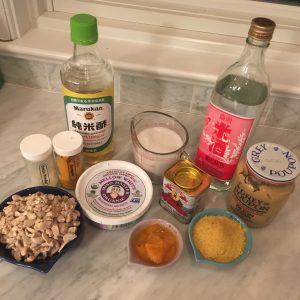


A couple nitpiks: Recipes labeled with cheesy names have to taste cheesy – nooch just doesn’t taste cheesy to me. And there isn’t any nutritional info – I’d like to know the calorie count and the percentage from fat – is it a 30-cal tablespoon or a 125 cal one? Also while the cashew craze has been well addressed, alternatives would be appreciated (since cashews are high-FODMAP) and a little more on aquafaba would also be helpful and suggestions for those among us who choose oil-free.
Bottom line – this book is a keeper. There are enough interesting concepts in here to encourage experimentation. It is not haute cuisine, but it is reliable, tasty, clean vegan. And that’s worth a lot.
Good Clean Food Shopping Smart to Avoid GMOs, rBGH and Products that may cause Cancer and other Diseases
By Samuel Epstein, MD and Beth Leibson – Skyhorse Publishing 2013. $24.95/ Amazon $16.99, $6.50 used

Dr. Epstein is a voice we should hear. His long and deep expertise on the avoidable causes of cancer has been shared in twenty books and 270 peer-reviewed articles. He is professor emeritus of environmental and occupational medicine at the University of Illinois School of Public Health and chair of the Cancer Prevention Coalition. He has also served as president of the Rachel Carson Council and other industry organizations. Co-author Beth Leibson knowledgeably unpacks this far-ranging erudition to make it accessible and understandable to the layperson.
This is a short read outlining important concepts that are clearly described – the main foci are:
Milk – the US permits the injection of the genetically-engineered growth hormone (rBGH – named by Monsanto Posilac) into dairy cows which causes elevated concentrations of IGF-1 (Insulin-like Growth Factor). The upside is that it increases milk production by 11-15%, the downside for the cow is that they get sick, for instance 25% get mastitis which adds more pus to the milk and which also requires antibiotics. About 20% of dairy farms in the US inject their herds with rBGH which creates IGF-1 but, since labeling is not required, consumers have no idea. The downside for the consumer, in addition to the antibiotic load, is that IGF-1, which is not destroyed by pasteurization, encourages cells to grow – in children it’s usually bones and organs, in adults it can be cancer cells. So, if you choose to continue to use dairy products, buy only organic from grass-fed herds. BTW: The EU and Canada outlawed rBCH and IGF-1 in the 90s. Better yet – plant milk.
Beef – Starting in the ‘50s, US cattle have been injected and/or fed a wide variety of sex hormones and other growth drugs. Today that cocktail, injected into 90% of all US cattle, contains natural estradiol, testosterone, and progesterone plus synthetic hormones zeranol, trenbolone, and melengesterol – all designed to add quick weight and roughly $80 additional profit per animal. The EU outlawed this practice in 1989. Industrial farmed meat cows are also fed prophylactic antibiotics which has contributed to the creation of superbugs that jump to humans and are resistant to most if not all antibiotics. Other beef topics include nitrates (and the link between hot dogs and pediatric brain cancer), radiation, the significant advantages of grass-fed beef and, again, the need for labeling.
Produce – The Dirty Dozen/Clean Fifteen – The Environmental Working Groups master list of the dozen most likely fruits and vegetables, when conventionally grown, to be drenched with pesticide – add kale and collards to the EWG list. The Clean Fifteen lists those least likely to be tainted. The authors also suggest buying “American” since imported produce usually contains higher percentages of pesticides. This chapter then details the negative effects of these insecticides and herbicides, many of which contain Organophosphates, which has been shown to block acetylcholinesterase that stops nerve cells from firing. The demonstrated effects include increased incidences of ADHD, autism, reduced memory and lowered IQ. The answer is organically grown produce.
Corn and Soybeans & GMOs – These are the two most prolific foods on the planet; corn, for instance, provides over 20% of all human nutrition – but both are largely used for animal feed. Both can be cultivated as vegetables or as oil or as…. The broad-spectrum herbicide Roundup, a ramped up version of Glyphosate (which is a type of organophosphate), was developed by Monsanto to increase field yields. Monsanto also developed many Roundup-ready, patented crop seeds that can tolerate the pesticide. Initially Roundup works, but then, over time, the weeds become resistance and the farmers find it necessary to increase the quantity of Roundup creating more dangerous conditions for farmers and consumers. Glyphosate-resistant alternatives exist but share the same problems – they kill off amphibians as well as pests and weeds and they contain an inert ingredient (a surfactant) to help the chemicals penetrate the plants which has shown to be harmful to humans. A newcomer is Bt corn (Bacillus thuringiensis), a plant that exudes its own pesticide which is also dangerous to other living things, like butterflies and humans. The chapter concludes with a review of the politics as well as alternatives – especially non-GMO organic.
Chicken & Eggs – Conventionally raised chickens (and eggs) are fed a wide range of ingredients to encourage speedy growth including prophylactic antibiotics – which pass to humans creating similar problems to those of beef. At first brush, the answer seems to be organic. In order to be labeled organic, broilers and egg-laying hens alike, must be fed organic feed without antibiotics (except for illness), hormones or pesticides and they must have access to the outdoors. An organic egg comes from an organic laying hen. But beware the various levels of “organic” – large-scale industrial and some family-size organic egg farms may offer an open door with an impenetrable maze to access it so there is no “scratching in the dirt.” The key descriptor seems to be “pasture-based” or “free-range” organic where mobile housing moves frequently to fresh fields and the birds are outdoors as often as inside. All of this applies to “broilers” as well.
Avoiding GMOs – This gets harder every day; again look for the word “organic” otherwise almost any, for instance, soybean or soybean derivative will likely be from GMO plants– but at least know the legal definitions: “100% organic” means just that. “Organic” means 95% of ingredients are. “Made form Organic Ingredients” 70-94% is organic. The word “organic” on the ingredient panel only means that less than 70% is organic. An on fruits and vegetables – look for a label with a 5-digit number beginning with 9 – that’s organic. Beginning with an 8 means GMO (but that’s rarely labeled). Four digits beginning with 3 or 4 means conventional.
The remainder of the book discusses detoxification and future trends like Budget organics – private labels, Farmers’ markets, CSAs Buying clubs, Food Co-ops. And trends among various ethnic groups and around the world – all of which are well worth reading. Finally check out the organic industry watch dog: Cornucopia Institute www.cornucopia.org.



